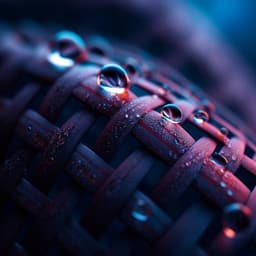
Engineering and Technology
Growing recyclable and healable piezoelectric composites in 3D printed bioinspired structure for protective wearable sensor
Q. He, Y. Zeng, et al.
Explore an innovative strategy to develop recyclable and healable piezoelectric Rochelle salt crystals in 3D-printed structures, enhancing smart monitoring devices. This groundbreaking research led by Qingqing He, Yushun Zeng, Laiming Jiang, and their colleagues examines the composite's mechanical and piezoelectric performance, showcasing applications like smart sensor armor for athletes and fall alarm pads for greater safety.
~3 min • Beginner • English
Introduction
Wearable bioelectronics for sports and gerontology require devices that simultaneously provide sensing and mechanical protection. Existing soft, flexible piezoelectric sensors and printed circuit-based wearables generally lack protective capability, whereas advanced protective armors (fibers, metals, ceramics) are typically not sensing. This gap motivates multifunctional wearable sensors that integrate protection and sensing for applications such as sports vests, space armor, and elderly protective gear. Nature provides inspiration via lightweight, high-strength structures; the cuttlefish bone’s chambered wall-septa microstructure offers high stiffness, energy absorption, and high porosity suitable as a multifunctional sensor scaffold. Conventional piezoelectric composites (1-3, 2-2) made by dicing-and-filling or molding face challenges with complex architectures. Additive manufacturing enables complex bioinspired designs. Rochelle salt (RS), an eco-friendly piezoelectric/ferroelectric crystal, can be synthesized easily, melted at relatively low temperatures, and recrystallized upon cooling, suggesting potential for healable, recyclable piezoelectric composites. The study aims to grow RS crystals within 3D-printed cuttlebone-inspired polymer structures to create a recyclable, healable composite that integrates mechanical protection and piezoelectric sensing, and to demonstrate its performance in smart armor and fall-detection knee pads.
Literature Review
Prior work on piezoelectric composites often employs dicing-and-filling techniques to form 1-3 or 2-2 architectures, which can be limited in realizing complex bioinspired microstructures and may require high-temperature processing that degrades performance. 3D-printed piezoelectric structures (e.g., honeycomb barium titanate filled with epoxy) demonstrate feasibility but still face process constraints. Bioinspired structures such as nacre and cuttlebone have inspired strong, lightweight materials with enhanced toughness and energy absorption. Rochelle salt has long been known as a ferroelectric/piezoelectric material and has recently been explored in eco-friendly, low-temperature, and even wood- or paper-based composites. The literature indicates a need for manufacturing routes that combine complex structural architectures with integrated piezoelectric function, healability, and recyclability for wearable sensing and protection.
Methodology
3D printing of biomimetic structures: Cuttlebone-inspired and comparison structures (cubic, honeycomb, triangular) were designed in SolidWorks and Fusion 360, sliced in CHITUBOX, and fabricated via DLP (Phrozen Sonic Mini 4K; resolution ~35 µm) using a photocurable resin (Phrozen Aqua-Gray 4K). Bottom exposure was 35 s to ensure adhesion to the platform; subsequent layers used 2.5 s exposure. Printed parts were washed in 99% isopropyl alcohol and UV post-cured for 15 min.
Rochelle salt (RS) solution preparation and crystal growth: RS (sodium potassium tartrate tetrahydrate, NaKC4H4O6·4H2O) was prepared by dissolving 80 g potassium bitartrate in 100 mL DI water at ~75 °C with stirring, periodically adding ~1 g sodium carbonate until bubbling ceased. For dense crystallization, crystals were dissolved at ~100 °C and water partially evaporated (~15 min), then allowed to stand 24 h; this step was repeated 3–5 times, yielding ~50 µm crystal particles. For composite fabrication, 3D-printed cuttlebone structures (typical element 10 mm × 10 mm × 3 mm; arrays 5.5 cm × 5.5 cm × 5 mm with 1 cm × 1 cm × 3 mm pixels) were immersed in molten RS solution to infiltrate the pores. After removal, RS crystals nucleated and grew along internal walls over time (60 min to 48 h) at room temperature, progressively filling voids.
Electrodes and devices: Silver electrodes (E-solder) were applied to top/bottom surfaces; copper wires connected elements to data acquisition (Analog Discovery 2) or Arduino microcontrollers. Arrays (4 × 4) were assembled for smart armor and a curved pad for knee protection.
Piezoelectric characterization: Direct piezoelectric response was measured by applying impacts/weights (1–20 g) in free-fall and cyclic motor-driven impacts (1–4 Hz). Output voltage was captured via Analog Discovery. Effective d33 was measured using a YE2730A d33 meter. Converse piezoelectric response was probed using a Polytec MSA-500 laser vibrometer under sinusoidal drive (−10 to 10 V; 0–20 kHz) to map out-of-plane displacement and phase; converse d33 was derived from linear fits of displacement versus voltage. Electrical impedance spectra were measured with an Agilent 4294A.
Mechanical testing: Compression and three-point bending tests were performed on an Instron 34SC-1. Static compression used 0.5 mm/s up to 7 mm. Three-point bending used 0.5 mm/s up to 3 mm on samples with/without notches. Single-edge-notched bend specimens (thickness 5 mm, notch depth 0.6 mm, width 5 mm, span 20 mm) were used to evaluate fracture toughness for crack initiation (KIC) and crack propagation (KJC) via J-integral analysis. SEM was used to image crack paths.
Simulation: COMSOL Multiphysics 5.6 simulated piezoelectric potential distribution and mechanical deformation. For piezoelectricity, a 10 N load was applied to the model with RS piezoelectric coefficients and multiple crystal orientations considered. Mechanical simulations examined deformation and crack deflection under 1 N load across different lattice architectures.
Healing and recycling: Damaged composites were healed by injecting RS solution into the damaged region and allowing 24 h growth at room temperature. For recycling, RS within composites was dissolved by immersing in heated DI water (~80 °C) for ~6 min; the polymer scaffold was then reused by re-immersing in the recycled RS solution to regrow crystals.
Smart device tests: Smart armor (4 × 4 array) was mounted on a football player model. Free-fall impacts with 5 g and 10 g weights from fixed heights were applied; voltages were converted to force maps using MATLAB. Pattern recognition (e.g., letters “SDSU”) was demonstrated by dropping shaped objects from 20 cm. After intentional damage, healing and recycling were validated by repeating mapping (e.g., letter “L” with a 3 × 3 array). For the smart knee pad, a curved 4 × 4 array interfaced with an Arduino, LED, and buzzer (threshold 900 mV) was tested under impacts at different knee regions and from different fall heights (chair, standing, stairs).
Key Findings
• RS crystals can be uniformly grown inside 3D-printed cuttlebone-inspired lattices, filling voids densely as confirmed by SEM/EDS and CT, yielding composites with integrated piezoelectricity and structural reinforcement.
• Direct piezoelectric output: A 20% polymer-volume cuttlebone composite produced up to ~8 V peak-to-peak when a 20 g mass was dropped from 50 mm. Cyclic impact tests (1–4 Hz) showed frequency-dependent outputs and stable performance up to ~6800 cycles; fracture initiated ~6800 cycles, with complete failure ~7000 cycles.
• Effective piezoelectric coefficient: d33 ≈ 30 pC/N (direct), confirmed by converse piezoelectric measurements via vibrometry with similar magnitude.
• Control materials (epoxy, silicone) in the same lattice showed negligible voltage under impact, and polarity reversal flipped output signs, confirming true piezoelectric origin.
• Mechanical performance: Among cubic, honeycomb, triangular, and cuttlebone lattices, the cuttlebone structure showed least deformation and most uniform stress under compression. Growing RS within the structure increased maximum compressive load beyond the polymer-only scaffold (~180 N baseline) and improved stiffness.
• Toughness and strength: Fracture toughness for crack initiation KIC reached 4.67 MPa·m^1/2 after 24 h of crystal growth, a 1044.6% increase over pure polymer. Flexural strength increased from 1.3 MPa (polymer) to 11 MPa (24 h growth), an 8.4× enhancement. Rising R-curve behavior indicated increasing resistance to crack propagation with greater crystal growth.
• Healing and recycling: Healed and recycled samples recovered piezoelectric and mechanical properties substantially. KIC recovery: 78.7% (healed) and 90.5% (recycled) relative to original; flexural strength recovery: 79.5% (healed) and 92.6% (recycled). Piezoelectric outputs of new composites from recycled RS approached ~95% of the original.
• Smart armor application: A 4 × 4 array mapped impact magnitude and location; distinct voltage responses scaled with 5 g vs 10 g impacts. Force distribution maps recreated shapes (e.g., letters “SDSU”). After healing damaged pixels, sensing capability was restored; recycling and regrowth enabled a 3 × 3 array to detect an “L” pattern.
• Smart knee pad: A curved 4 × 4 array differentiated inner/outer/center knee impacts and fall severities. Peak-to-peak voltages increased with fall height: ~7 V (chair), ~11 V (standing), ~20 V (stairs). A 900 mV threshold reliably triggered buzzer/LED alarms.
Discussion
The work demonstrates a manufacturable route to integrate high-impact mechanical protection with piezoelectric sensing by growing Rochelle salt crystals inside a bioinspired 3D-printed cuttlebone lattice. The wall–septa architecture provides stiffness, energy absorption, and controlled crack deflection/branching, while RS imparts strong piezoelectric response. The effective d33 (~30 pC/N) and voltages at relatively low impact forces compare favorably to other 3D-printed piezoelectric systems. The composites maintain sensing performance over thousands of impact cycles and, when damaged, can be healed or fully recycled through RS dissolution and regrowth with substantial recovery of mechanical and electrical performance. Practical demonstrations in smart armor and a fall-detection knee pad highlight accurate localization and magnitude mapping of impacts, as well as actionable alerts. Together, these results address the initial challenge of unifying protection and sensing in a lightweight, conformable form factor and suggest a pathway for sustainable, repairable wearables in sports, medical, and defense contexts.
Conclusion
A recyclable, healable piezoelectric composite was realized by growing Rochelle salt crystals within a 3D-printed cuttlebone-inspired polymer scaffold. The composite exhibits robust piezoelectricity (effective d33 ~30 pC/N), high voltage outputs under low-force impacts, and markedly enhanced mechanical performance (over 10× increases in fracture toughness and flexural strength vs polymer). Healing and recycling restore most of the original functionality, enabling sustainable device lifecycles. Demonstrations in smart armor for athletes and a fall-detection knee pad validate integrated protection and sensing with spatial force mapping and alerting. Future research could optimize environmental stability and packaging, scale manufacturing and array sizes, tailor crystal orientation and lattice geometry for anisotropic responses, and evaluate long-term durability and biocompatibility in real-world conditions.
Limitations
The study reports device stability to approximately 7000 impact cycles before failure under the tested conditions; longer-term fatigue performance and environmental stability (e.g., humidity, temperature, liquid exposure) were not comprehensively evaluated. Demonstrations focus on specific geometries (4 × 4 and 3 × 3 arrays) and lab-scale prototypes; scalability, miniaturization, and integration with wearable systems beyond benchtop setups were not fully explored. While healing and recycling restore a high fraction of performance, they do not fully recover to 100% in all metrics.
Related Publications
Explore these studies to deepen your understanding of the subject.







